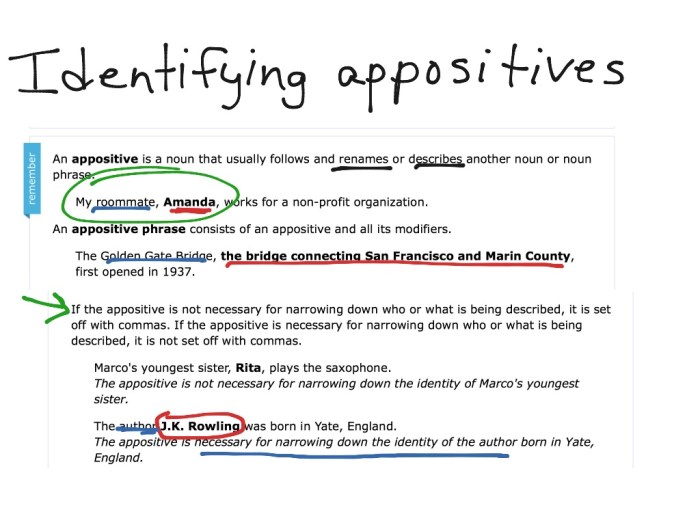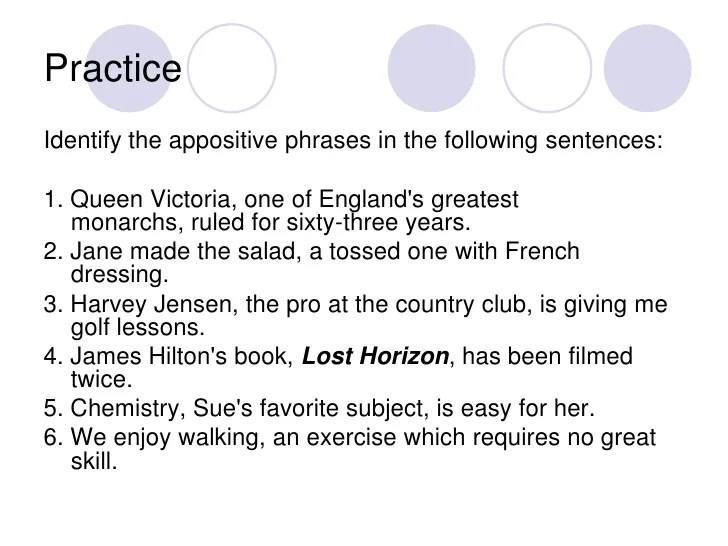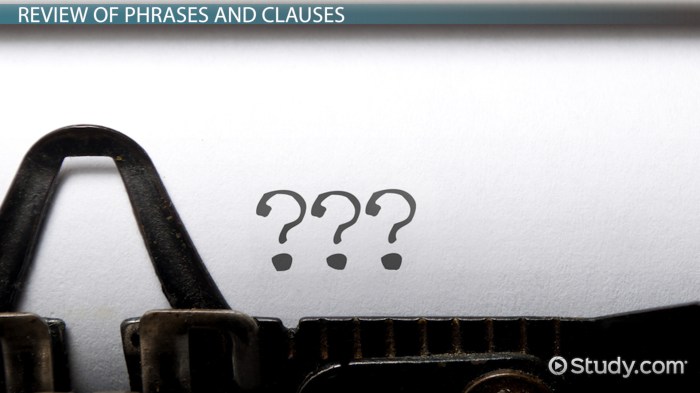Prepositional phrases appositives and appositive practice – In the realm of grammar, prepositional phrases and appositives serve as essential tools for enhancing clarity, precision, and sophistication in writing and communication. This comprehensive guide delves into the intricacies of these grammatical elements, providing a thorough understanding of their definitions, functions, and effective usage.
Prepositional phrases, acting as modifiers, add specific details to nouns or pronouns, while appositives, serving as renamers or identifiers, provide additional information about a preceding noun or pronoun. Together, they contribute to the richness and accuracy of language.
Prepositional Phrases

A prepositional phrase consists of a preposition, its object, and any modifiers of the object. Prepositions are words that show the relationship between a noun or pronoun and another word in the sentence. Common prepositions include “on,” “at,” “in,” “to,” “from,” and “with.”
Prepositional phrases can function as adjectives, adverbs, or nouns. For example, in the sentence “The cat sat on the mat,” the prepositional phrase “on the mat” functions as an adjective, describing where the cat is sitting. In the sentence “I walked to the store,” the prepositional phrase “to the store” functions as an adverb, describing the direction of the action.
In the sentence “The gift from my friend,” the prepositional phrase “from my friend” functions as a noun, identifying the giver of the gift.
Types of Prepositional Phrases
- Adjectival prepositional phrases: Describe nouns or pronouns and answer the questions “which one?” or “what kind?”
- Adverbial prepositional phrases: Describe verbs, adjectives, or other adverbs and answer the questions “when?”, “where?”, “how?”, or “why?”
- Noun prepositional phrases: Function as nouns and can be the subject, object, or complement of a sentence.
Appositives
An appositive is a noun or noun phrase that renames or identifies another noun or noun phrase. Appositives are usually placed next to the noun they rename and are often set off by commas. For example, in the sentence “My friend, John, is a teacher,” the appositive “John” renames the noun “friend.”
Appositives can provide additional information about the noun they rename. For example, in the sentence “The president, Joe Biden, gave a speech,” the appositive “Joe Biden” provides the name of the president.
Types of Appositives, Prepositional phrases appositives and appositive practice
- Restrictive appositives: Essential to the meaning of the sentence and cannot be removed without changing the meaning.
- Nonrestrictive appositives: Provide additional information but are not essential to the meaning of the sentence and can be removed without changing the meaning.
Appositive Practice

Exercises
- Identify the prepositional phrases in the following sentences and state their function (adjective, adverb, or noun):
- The cat sat on the mat.
- I walked to the store.
- The gift from my friend arrived yesterday.
- Identify the appositives in the following sentences and state whether they are restrictive or nonrestrictive:
- My friend, John, is a teacher.
- The president, Joe Biden, gave a speech.
Table of Examples
| Prepositional Phrase | Function | Appositive | Type |
|---|---|---|---|
| on the mat | Adjective | John | Restrictive |
| to the store | Adverb | Joe Biden | Nonrestrictive |
| from my friend | Noun |
Additional Examples and Applications

Prepositional phrases and appositives are commonly used in both written and spoken language. Here are some examples from various sources:
Literature
“The old man, his face weathered by time, sat on the porch.” (from “The Great Gatsby” by F. Scott Fitzgerald)
News Articles
“President Biden, the oldest person to ever serve as president, gave a speech on the economy.”
Everyday Speech
“I’m going to the store to buy some milk.”
“My friend John is a teacher.”
Importance of Using Prepositional Phrases and Appositives
Prepositional phrases and appositives are essential for clear and concise writing and communication. They provide additional information, describe relationships between words, and help to avoid ambiguity.
Tips for Incorporating Prepositional Phrases and Appositives Effectively
- Use prepositional phrases to add detail and clarity to your writing.
- Use appositives to provide additional information about nouns or noun phrases.
- Make sure that your prepositional phrases and appositives are grammatically correct.
- Avoid using too many prepositional phrases or appositives, as this can make your writing difficult to read.
Query Resolution: Prepositional Phrases Appositives And Appositive Practice
What is the primary function of a prepositional phrase?
A prepositional phrase modifies a noun or pronoun by providing additional information about its location, time, manner, or other relationships.
How do appositives contribute to sentence structure?
Appositives provide essential information about a preceding noun or pronoun, clarifying its identity, nature, or characteristics.
What is the difference between a restrictive and a nonrestrictive appositive?
A restrictive appositive is essential to the meaning of the sentence, while a nonrestrictive appositive provides additional but nonessential information.